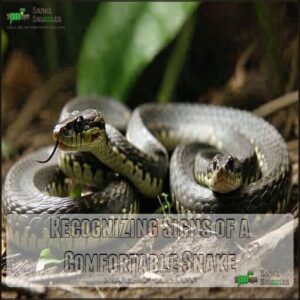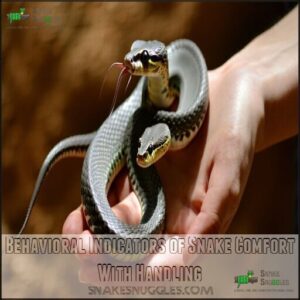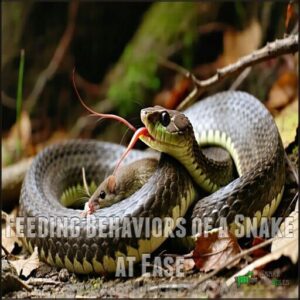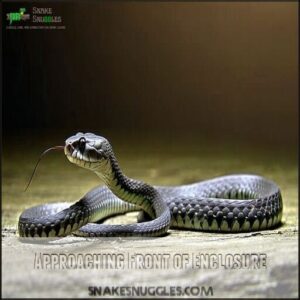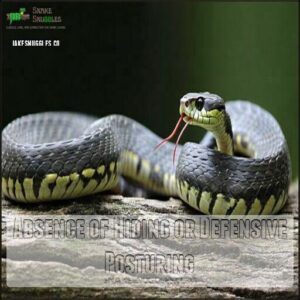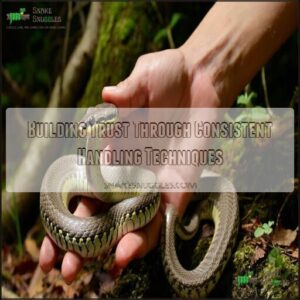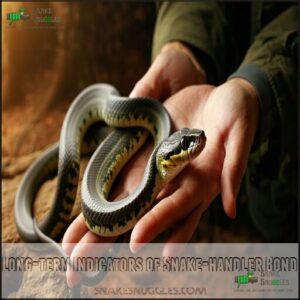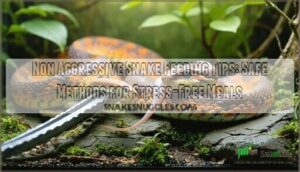This site is supported by our readers. We may earn a commission, at no cost to you, if you purchase through links.
 When you’re wondering how to tell if a snake is comfortable with you, watch for telltale signs of relaxation.
When you’re wondering how to tell if a snake is comfortable with you, watch for telltale signs of relaxation.
A content snake moves slowly and smoothly, with gentle, unhurried body language.
You’ll notice it doesn’t recoil when you approach or handle it, and its tongue flicks casually without agitation.
When comfortable, snakes will explore their surroundings calmly, drape themselves naturally around your hands, and show zero defensive behaviors like hissing or striking.
Pay attention to its body posture – a relaxed snake will have a loose, uncurled shape and won’t seem tense or ready to bolt.
Curious about what else your scaly friend might be telling you?
Table Of Contents
- Key Takeaways
- Recognizing Signs of a Comfortable Snake
- Body Language Cues of a Content Snake
- Behavioral Indicators of Snake Comfort With Handling
- Feeding Behaviors of a Snake at Ease
- Snake’s Response to Your Presence in Enclosure
- Distinguishing Comfort From Food-seeking Behavior
- Building Trust Through Consistent Handling Techniques
- Environmental Factors Affecting Snake Comfort Levels
- Long-term Indicators of Snake-handler Bond
- Frequently Asked Questions (FAQs)
- How do you know if a snake is comfortable?
- How do you know if a snake is happy?
- How do you know if a snake likes you?
- How do you know if a snake is safe?
- How can you tell if a snake is stressed?
- How can you tell if a snake is sleeping?
- How do you know if a snake is nervous?
- How do you know if a snake is sick?
- How do you tell if a snake likes you?
- How can you tell a snake is happy?
- Conclusion
Key Takeaways
- You’ll recognize a comfortable snake by its smooth, unhurried body movements and relaxed posture – they’ll explore calmly without tension or defensive positioning.
- Pay attention to your snake’s tongue flicking – gentle, methodical flicks signal curiosity and comfort, while rapid or aggressive flicking indicates stress or potential threat.
- A content snake will allow handling without recoiling, draping naturally across your hands and continuing normal activities like basking or exploring after being set down.
- Your handling technique matters immensely – move slowly, support their entire body, respect their boundaries, and create a predictable environment to build trust over time.
Recognizing Signs of a Comfortable Snake
If you’re wondering whether your snake truly feels comfortable around you, understanding its body language is key to building a trusting relationship.
Recognizing subtle signs like calm movements, relaxed posture, and gentle tongue flicking can help you interpret your snake’s emotional state and create a positive, stress-free environment.
Calm, Unhurried Movements
Let’s explore the art of reading your snake’s smooth exploration patterns. A comfortable snake speaks volumes through its calm movements, revealing deep insights into its emotional state.
A snake’s graceful slither whispers stories of trust, revealing the hidden language of reptilian comfort and connection.
Here are five key calm behavior indicators:
- Gentle, purposeful slithering without abrupt shifts
- Flowing motions across different surfaces
- Unhurried investigation of surroundings
- Steady progression during handling
- Relaxed tracking of environmental changes
When your snake moves with such graceful, slow movements, it’s signaling something essential: complete trust in its environment. These relaxed body language cues demonstrate your snake feels secure, transforming mysterious reptilian communication into a clear, reassuring message of comfort.
Relaxed Body Posture
Decoding a snake’s relaxed body posture reveals fascinating insights into their comfort zone. Your scaly companion communicates volumes through subtle physical cues that signal true snake relaxation.
- Smooth, continuous body curves without sharp angles
- Soft, pliable muscles under gentle exploration
- Evenly spaced coils during resting periods
- Level neck and head alignment
- Unclenched, freely moving tail
When a snake feels secure, its body tells a story of calm slither and gentle curves. Relaxed immobility transforms their physical form into a fluid, natural state. By understanding these nuanced trust signs, you’ll gain deeper communication with your reptilian friend, recognizing the intricate language of snake body language.
Tongue Flicking Without Agitation
Because a snake’s tongue is its sensory roadmap, understanding its tongue flicking patterns reveals essential comfort signals.
When your snake explores calmly, its tongue movements will be slow, steady, and deliberate—a silent language of relaxed curiosity. Gentle, rhythmic probing indicates environmental comfort and trust.
These smooth, sustained tongue flicks aren’t random; they’re your snake’s way of carefully tasting and mapping its surroundings. Watch for these subtle cues: soft, methodical movements that whisper confidence and ease, transforming tongue flicking from a mere biological function into a nuanced communication of snake well-being.
These movements are a key part of understanding your snake’s behavior, and recognizing them can help you provide a comfortable and trust-filled environment for your pet.
Willingness to Explore Surroundings
In the realm of reptile companionship, your snake’s willingness to explore speaks volumes about its comfort and trust.
Observing its environmental interactions reveals fascinating insights into its psychological state.
- Confidently investigates novel enrichment objects
- Moves steadily across different enclosure levels
- Maintains relaxed body positioning during movement
- Frequently utilizes climbing structures and hiding spots
- Methodically examines environmental modifications
Curious behavior isn’t just movement—it’s a language of its own.
When your snake glides smoothly through its habitat, thoroughly inspecting new substrate or decor without hesitation, you’re witnessing a profound expression of environmental confidence.
These exploration patterns are powerful snake trust signs, indicating a reptile feeling secure and thriving in its carefully crafted comfort zone.
Understanding snake body language is essential for recognizing signs of a comfortable snake and building trust with your pet.
Absence of Defensive Behaviors
Peering into your snake’s world reveals fascinating insights about its comfort level through distinct defensive behavior patterns.
When truly at ease, your reptilian friend exhibits a markedly different demeanor than a stressed creature.
- No aggressive posturing or sudden lunges
- Fluid, smooth body movements without tension
- Relaxed coils draped naturally, not tightly wound
- Calm exploration without constant defensive retreat
Your snake’s gentle movements communicate trust, signaling it perceives you as a non-threat.
By recognizing these no-striking, calm posture indicators, you’ll decode the subtle language of snake comfort.
Understanding these defensive behavior cues transforms your interaction from cautious handling to a harmonious bond rooted in mutual respect and understanding.
Body Language Cues of a Content Snake
When you understand snake body language, you’ll discover their silent communication.
A relaxed snake reveals itself through soft muscles and calm movements.
Look for gentle exploration patterns—loose, flowing coils instead of rigid angles.
Their head sits neutrally, not tensed for defense.
Slow, methodical tongue flicks indicate curiosity, not alarm.
These relaxed body posture cues speak volumes about a snake’s comfort level, showing they feel safe and content in their environment.
Each subtle signal tells a story of trust.
By recognizing snake communication signs, owners can better interpret their pet’s needs and emotions.
Behavioral Indicators of Snake Comfort With Handling
When handling snakes, understanding their body language is essential for building trust and ensuring both your safety and the snake’s comfort.
By recognizing specific behavioral indicators, you’ll learn to interpret whether your snake feels secure and relaxed during interactions, transforming your handling experience from potentially stressful to mutually enjoyable.
This understanding allows for a more positive interaction, where complete concepts of snake behavior are grasped, leading to a better handling experience.
Allowing Gentle Touch Without Recoiling
Detecting snake comfort through gentle touch reveals an intricate dance of trust. Your fingertips become a communication channel, translating subtle signals of relaxation and acceptance.
- Relaxed muscle tone signals handling tolerance
- Consistent calm responses indicate growing connection
- Minimal flinching demonstrates increasing confidence
Master snake handling by respecting their personal space and reading their body language. Start with brief, soft contacts that gradually expand as your reptilian friend becomes more comfortable. Each successful interaction builds a foundation of mutual understanding, transforming tentative touches into a language of trust and safety.
Patience becomes your greatest tool in developing a harmonious relationship. Understanding snake handling techniques is essential for a safe and enjoyable experience.
Remaining Calm During Lift and Support
After mastering gentle touch, your next skill is lifting and supporting your snake with confidence. Proper Lift Techniques and Support Methods are key to snake calm indicators.
Handling a snake requires a delicate balance of security and freedom. Focus on these snake comfort zone principles:
- Distribute weight evenly across your hands
- Use slow, predictable movements
- Keep your grip firm but not restrictive
- Maintain a relaxed body posture yourself
When you lift your snake, watch for relaxed body posture and smooth breathing. A comfortable snake will exhibit unhurried muscle tone, showing no signs of tension. Avoid restraining the head – let your reptile friend rest naturally across your palms.
Trust building happens through consistent, gentle handling. Your calm demeanor speaks volumes, signaling safety to your snake. With practice, you’ll develop an intuitive understanding of your snake’s comfort level during each interaction.
Exploring Handler’s Arms or Lap
When your snake begins arm exploration, you’ll witness a remarkable display of handler trust.
A comfortable snake will gracefully drape across your lap, flicking its tongue to map out your warmth and presence.
These gentle wrapping movements reveal deep snake curiosity and signal they’re entering their snake comfort zone.
Support their entire body, letting them navigate your arms with calm, deliberate movements that speak volumes about your growing bond.
Absence of Striking or Hissing
As your snake gracefully explores your arms from the previous section, pay close attention to its calm behavior. A truly comfortable reptile demonstrates no aggressive tendencies, revealing profound Trust Signals through peaceful coexistence.
Key indicators of No Aggression include:
- Relaxed muscles without defensive coiling
- Absence of hissing or striking warnings
- Gentle, methodical tongue flicks
- Smooth, unhurried body language
Professional snake handlers recognize these snake behavior signs as powerful communication. When your snake remains composed, you’ve successfully created an environment of mutual respect and safety.
Returning to Normal Activities After Handling
A reptilian thermometer of sorts, your snake’s post-handling behavior reveals volumes about their comfort level.
After you set them down, watch closely as they seamlessly shift back to their routine—exploring, drinking, or basking without hesitation.
These calm resumption signals demonstrate profound trust and successful handling recovery.
A relaxed snake treats interaction as just another moment in their day, flicking their tongue softly and moving with fluid grace.
Their ability to quickly return to normal feeding and activities indicates they’re not just tolerating you—they’re comfortable with your presence, and this is a sign of successful handling.
Feeding Behaviors of a Snake at Ease
Every snake tells a story through its feeding ritual, revealing comfort levels that speak volumes about its well-being.
When your serpentine friend is truly at ease, you’ll witness unmistakable signs of relaxed eating:
- Clear, steady tongue flicks signaling readiness
- Smooth, efficient prey strikes without hesitation
- Consistent appetite matched with peaceful digestion
Your snake’s eating habits are a window into its inner world. Watch for confident food approaches, appropriately sized prey selection, and calm post-meal behavior.
These snake feeding cues aren’t just about hunger—they’re a sophisticated language of comfort, showing how secure your reptilian companion feels in its environment. Understanding these subtle signals transforms your connection from mere observation to genuine communication.
By mastering proper snake feeding techniques, you can create a stress-free environment that promotes healthy growth and development.
Snake’s Response to Your Presence in Enclosure
When you step near a snake’s enclosure, its body language speaks volumes about its comfort level with your presence.
You’ll want to know how to read these subtle cues that reveal whether your slithery companion feels secure or stressed.
Approaching Front of Enclosure
Occasionally, a snake’s approach to the enclosure’s front signals more than mere curiosity.
Calm, deliberate movements toward you reveal intricate body language communicating comfort and recognition. Observe the nuanced signs: a steady gaze, relaxed posture, and unhurried progression.
These snake approach signs demonstrate a reptile’s growing trust and spatial awareness. The front presence isn’t just movement—it’s a sophisticated communication method.
By understanding these subtle cues, you’ll decode your snake’s comfort levels and build a deeper connection, transforming routine interactions into meaningful exchanges of reptilian trust.
Showing Interest Without Fear
Right in between the glass walls, your snake reveals its inner curiosity with a remarkable display of trust.
Watch for these telltale signs of comfort:
- Steady tongue flicks exploring your presence
- Smooth, unhurried movements across the enclosure
- Alert yet relaxed body language
A fearless approach signals growing confidence.
Your snake’s gentle exploration demonstrates a developing bond, transforming defensive instincts into open, trusting interactions that speak volumes about your careful handling.
Maintaining Relaxed Posture
Snake body language is a window into their emotional world.
When feeling secure, your snake reveals relaxed coils and a soft, elongated form that whispers comfort.
Their calm movements and gentle slither showcase a loose posture, free from muscle tension.
A comfortable snake drapes itself naturally, like a silk scarf hanging effortlessly.
These subtle cues of snake relaxation – soft muscles and unhurried positioning – demonstrate their sense of safety, telling you they’re at ease in their environment, which is a sign of their overall sense of safety.
Absence of Hiding or Defensive Posturing
A relaxed snake reveals profound insights through its body language during enclosure interactions.
When comfortable, your reptilian companion demonstrates remarkable trust by maintaining an open, non-defensive posture.
Key comfort indicators include:
- Staying visible without seeking immediate cover
- Displaying smooth, flowing movements without sudden jerks
- Exhibiting calm tongue flicking patterns without agitation
Experienced handlers recognize that a snake’s defensive behaviors dramatically contrast with relaxed body posture. Instead of coiling into an S-shape or preparing to strike, a content snake will remain calm and accessible.
Your gentle approach and consistent handling help create an environment where your snake feels secure enough to maintain a visible, open presence.
Understanding these subtle cues transforms your interaction from mere proximity to a nuanced communication, revealing the intricate language of snake relaxation and trust.
Continuing Normal Activities
When your snake continues its routine while you’re nearby, it’s revealing a profound sense of comfort and trust. Think of it as their silent communication, saying, "You’re part of my world now."
Watch for these telltale signs of snake relaxation:
- Smooth movement between hiding spots with a relaxed body posture
- Consistent normal feeding patterns without disruption
- Calm exploration of the enclosure with gentle tongue flicking
A snake maintaining regular activities—like basking under heat lamps, shedding normally, and breathing steadily—demonstrates deep trust. Their gentle interaction and unhurried behavior speak volumes about their sense of security. Your presence has become a non-threatening part of their environment, a demonstration of successful trust building and snake-friendly behavior.
Distinguishing Comfort From Food-seeking Behavior
When handling a snake, you’ll need to quickly distinguish between its curious exploration and potential feeding response.
Understanding subtle body language cues will help you recognize whether your snake is seeking comfort or anticipating a meal, which involves recognizing whether it is in a state of curious exploration.
Differences in Tongue Flicking Patterns
You’ll uncover a snake’s inner world through its intricate tongue flicking patterns.
Subtle variations in tongue flick rates reveal critical insights into your reptilian companion’s emotional state.
Comfortable snakes display calm, methodical tongue flicking—a gentle exploration of their environment that signals relaxation and curiosity.
In contrast, food-seeking behaviors trigger rapid, focused tongue flicks designed to track potential prey with precision.
These nuanced tongue flicking behaviors serve as a window into snake communication.
Each deliberate flick represents a sophisticated sensory investigation, gathering chemical information about surroundings.
Scientifically speaking, tongue function goes beyond simple movement—it’s a complex mechanism for understanding environmental context.
By mastering the art of interpreting flick patterns, you’ll decode your snake’s unspoken language, transforming your understanding of these fascinating creatures.
Head Positioning and Tracking
After uncovering tongue flicking nuances, your snake’s head positioning becomes the next detective clue to their inner world.
Head tracking reveals volumes about their comfort level and intentions.
Peek into their emotional landscape with these key observations:
- Subtle head tilt communicates curiosity
- Gentle eye contact signals relaxation
- Natural neck alignment shows contentment
- Smooth, unhurried movements indicate trust
Professional snake handlers know that a snake’s head positioning is like reading an intricate body language map.
During calm moments, their head rests neutrally, neither raised in high alert nor rigidly focused.
The neck flows seamlessly, whispering stories of a comfortable, secure companion ready to explore their environment, showing contentment and relaxation with gentle eye contact and smooth movements.
Body Tension Levels
Though body tension speaks volumes, understanding your snake’s muscular landscape reveals its true emotional state.
Muscle relaxation is your roadmap to snake comfort:
- Loose, fluid movements signal contentment
- Rigid muscles indicate potential stress
- Sudden stiffness suggests defensive preparation
Your snake’s body language tells a nuanced story. By mastering tension signs, you’ll decode subtle comfort signals and build a deeper connection with your serpentine companion, transforming handling from guesswork to intuitive communication. This understanding will help you recognize when your snake is experiencing potential stress.
Response to Non-food Stimuli
A leaf rustling might reveal volumes about your snake’s inner world of snake body language.
Comfortable snakes greet non-food stimuli with calm curiosity, displaying gentle exploration without defensive tension.
Their handling tolerance shines through relaxed, unhurried movements and soft tongue flicks that taste the environment.
Watch for snake relaxation cues like smooth, deliberate investigations of new objects—these signal trust and comfort.
Unlike stressed reptiles that jerk or freeze, a content snake approaches novel experiences with an open, inquisitive demeanor.
Your touch response becomes a dance of mutual understanding, where gentle interactions speak louder than words, and snakes display relaxed, unhurried movements with soft tongue flicks.
Timing in Relation to Feeding Schedule
A snake’s feeding schedule is a roadmap to understanding its behavior and comfort levels.
By tracking meal timing and hunger signs, you’ll decode your snake’s language with precision.
- Observe feeding cues and digestion cycles
- Respect post-meal boundaries to build trust
Learn when your snake is truly comfortable versus simply seeking its next prey, ensuring a harmonious handler-snake relationship.
Building Trust Through Consistent Handling Techniques
Building trust with your snake isn’t just about technique—it’s about understanding their unique body language and respecting their boundaries.
By learning to read subtle cues and consistently practicing gentle, confident handling, you’ll transform your relationship from mere interaction to a genuine connection.
Proper Support and Grip
When handling snakes, master the art of a gentle grip. Support their body’s weight naturally across your arm, allowing them to feel safe and unrestricted. Your confidence matters as much as technique.
Using proper snake handling tools is essential for safe interactions.
| Snake Size | Handling Method | Body Position |
|---|---|---|
| Small | Cradle gently | Relaxed curves |
| Medium | Midline support | Balanced spread |
| Large | Firm midsection | Comfortable drape |
Snakes sense your approach—move smoothly, breathe calmly, and respect their space.
Gradual Acclimation to Touch
Four key strategies will transform your snake’s touch introduction and desensitization process.
- Move with glacial slowness, telegraphing every motion
- Approach with feather-light, predictable touches
- Watch for subtle stress signals intently
- Pause and retreat if snake shows discomfort
Gentle handling isn’t just technique—it’s an art of building trust, creating a calm interaction that speaks volumes about your snake’s comfort and your understanding.
Respecting Snake’s Boundaries
Learning to read your scaly friend’s body language is like decoding a secret communication system.
Your snake communicates comfort and discomfort through subtle signals you’ll want to master.
When your pet starts pulling away or tensing up, it’s broadcasting clear "stop" signals that demand your immediate attention.
Snake Consent Action
Recognizing snake boundaries isn’t just about safety—it’s about trust building.
Every gentle step back when they’re stressed shows you respect their comfort zones.
By tuning into these stress signals, you’ll develop a deeper, more responsive relationship with your slithery companion.
Maintaining Calm Demeanor
Your snake-handler dance requires precision and patience. Mastering calm movements helps your reptilian friend feel secure and understood.
Here’s how to transform your interactions into trust-building moments:
- Move like a gentle breeze, never sudden or jarring
- Support the entire body with confident, steady hands
- Breathe slowly and maintain a relaxed posture
- Create a quiet, predictable environment for exploration
Creating Positive Associations
In through the front door of snake socialization, you’ll want to create an environment where your reptilian friend sees you as a safe, predictable presence.
Trust building happens slowly, through consistent, gentle interactions that reinforce positive associations.
Your calm demeanor and methodical approach become the secret handshake of handler confidence, gradually transforming wariness into comfortable familiarity, fostering a sense of trust.
Environmental Factors Affecting Snake Comfort Levels
You can’t understand your snake’s comfort levels without knowing how environmental factors play a vital role in their well-being.
The right temperature, humidity, hiding spots, and enclosure setup are key to creating a stress-free environment that helps your snake feel secure and content.
Proper Temperature and Humidity
Because every snake craves its perfect climate, mastering temperature and humidity is vital for their well-being. Creating an ideal thermal environment transforms your enclosure into a snake sanctuary.
- Monitor temperature gradients using reliable digital thermometers
- Provide heat sources that mimic natural basking conditions
- Maintain species-specific humidity levels for superior health
- Use digital hygrometers to track moisture precisely
Temperature control is more than a luxury—it’s survival. Most snakes thrive between 68°F and 80°F, with basking spots reaching 85°F. Tropical species demand higher humidity, while desert dwellers require drier conditions. Extreme temperatures trigger stress, dehydration, and feeding disruptions.
By understanding your snake’s thermal needs, you’ll create a comfortable, stress-free habitat that supports their natural behaviors and overall wellness. Accurate temperature readings from a digital thermometer are essential for maintaining this balance.
Adequate Hiding Spots
The sanctuary of hiding spots is your snake’s psychological lifeline.
Create a diverse landscape with log, rock, cave, and plant hides that offer visual barriers and security.
Strategically place multiple hiding spots on warm and cool enclosure sides, ensuring each hide accommodates your snake’s full body—transforming their space from mere habitat to a stress-free haven of comfort, and making the enclosure a true sanctuary by providing a diverse landscape.
Appropriate Enclosure Size
Designing the perfect snake habitat starts with space requirements that mirror their natural stretching instincts.
Your snake’s enclosure should accommodate its full length and movement patterns:
- Length: At least 1.5x snake’s body length
- Width: Approximately half their total length
- Height: Vertical space for climbing species
- Volume: Promotes comfortable exploration and natural behaviors
Prioritize habitat volume to promote snake comfort and well-being.
Regular Cleaning and Maintenance
Your snake’s well-being hinges on thorough habitat maintenance. Regular cleaning prevents bacterial buildup and keeps your slithery friend healthy.
| Task | Frequency | Purpose |
|---|---|---|
| Spot Cleaning | Daily | Remove waste |
| Wall Wipe-down | Weekly | Control humidity |
| Substrate Change | Bi-monthly | Prevent bacterial growth |
| Water Bowl Cleaning | Daily | Guarantee fresh water |
| Full Enclosure Sanitization | Monthly | Deep clean environment |
Effective snake enclosure hygiene isn’t just about cleanliness—it’s about creating a stress-free environment. Consistent maintenance signals to your snake that their home is safe and comfortable.
By implementing a structured cleaning schedule, you’ll prevent potential health issues and also build trust with your reptilian companion. Using proper snake cleaning tools is essential for maintaining a clean environment. Precision and regularity are your best tools in snake environment maintenance.
Minimizing Stress-inducing Stimuli
Several critical strategies help minimize stress-inducing stimuli for pet snakes, creating a peaceful habitat. Consider these key stress reduction techniques:
- Maintain low ambient noise levels
- Use soft, dim lighting
- Limit frequent handling
- Create predictable interaction patterns
Gentle handling and calm environments are essential for snake relaxation. By understanding and implementing these principles, you’ll help your snake feel secure and comfortable in its surroundings.
Creating a snake friendly environment involves understanding the importance of snake habitat design to reduce stress and promote well-being.
Long-term Indicators of Snake-handler Bond
You’ll know you’ve successfully bonded with your snake when its consistent, positive reactions reveal a deep trust that transcends mere tolerance.
Over time, you’ll observe your snake’s reduced stress during handling, willingness to interact, and overall thriving demeanor, which are the true hallmarks of a strong snake-handler relationship.
Consistent Positive Reactions Over Time
Your pet reptile’s journey to trust is like a slow dance of mutual understanding.
Consistent interactions gradually chip away at their natural wariness, revealing a deeper connection.
- Habituation reduces fear responses through gentle, predictable handling
- Long-term bonding transforms initial hesitation into confident interaction
- Handler’s steady presence signals safety and builds snake-human rapport
Trust emerges as your snake recognizes your familiar touch and calm demeanor.
This mutual understanding is the foundation of a strong bond between you and your pet reptile.
Reduced Stress During Necessary Procedures
When your scaly friend faces a stress-inducing procedure, understanding calming techniques can make all the difference.
Gentle restraint transforms challenging moments into trust-building opportunities.
| Stress Signs | Calming Actions | Handler’s Goal |
|---|---|---|
| Tail Twitching | Slow Movements | Reduce Anxiety |
| Tight Coiling | Soft Support | Build Confidence |
| Rapid Tongue Flicks | Steady Breathing | Guarantee Safety |
Master snake relaxation—your bond depends on it.
Willingness to Be Handled Regularly
Your snake’s willingness to be handled reveals a deepening bond. Consistent, gentle interactions transform defensive reactions into trust-building moments.
- Snake trust grows with predictable, calm approaches
- Regular handling techniques reduce stress
- Gentle touch communicates safety and connection
Mastering snake handling safely means reading body language, respecting boundaries, and creating positive associations that make your reptilian friend feel secure.
Maintaining Healthy Appetite and Growth
In the depths of your snake’s care, healthy appetite and growth emerge as telltale signs of a thriving companion.
Watch for these key indicators:
- Consistent feeding rhythm: Regular meals without hesitation signal comfort and well-being.
- Gradual weight progression: Track steady growth and sturdy shedding cycles.
- Hydration and nutrition balance: Guarantee fresh water and balanced diet support peak health.
Your attentive care transforms feeding from a routine into a trust-building ritual, nurturing your snake’s healthiness.
Overall Thriving in Captive Environment
Thriving in captivity isn’t just about survival—it’s about creating a sanctuary where your snake feels secure and vibrant.
Master the art of environmental enrichment by providing a stress-free habitat that mirrors natural conditions.
Your commitment transforms a simple enclosure into a haven of reptile wellness, where comfort, nutrition, and handler interaction converge.
| Habitat Element | Importance | Impact on Snake |
|---|---|---|
| Proper Humidity | High | Supports Healthy Shedding |
| Temperature Gradient | Critical | Regulates Metabolism |
| Multiple Hiding Spots | Essential | Reduces Stress |
| Clean Environment | Necessary | Prevents Disease |
| Consistent Routine | Key | Builds Trust |
Frequently Asked Questions (FAQs)
How do you know if a snake is comfortable?
A comfortable snake moves smoothly, explores calmly, and flicks its tongue gently.
It doesn’t hide or show defensive postures.
When handled, it relaxes, drapes comfortably, and shows curiosity without aggressive behaviors, demonstrating a comfortable demeanor throughout the interaction.
How do you know if a snake is happy?
A happy snake moves slowly and confidently, explores its surroundings calmly, flicks its tongue gently, and shows no signs of stress like hissing or jerky movements.
It maintains a relaxed body posture and willingly interacts with its environment, which can be characterized by no signs of stress.
How do you know if a snake likes you?
Slithery signs show snake satisfaction: watch for calm exploration, gentle tongue flicks, relaxed body posture, and willingness to be handled without defensive behaviors.
Your snake’s comfort reveals itself through unhurried, curious interactions.
How do you know if a snake is safe?
Watch for calm body language, steady breathing, and no defensive postures.
Check if the snake moves slowly, flicks its tongue gently, and doesn’t coil tightly or attempt to strike when approached, exhibiting calm behavior.
How can you tell if a snake is stressed?
When a snake feels like a coiled spring ready to snap, it’ll telegraph its stress through tight body language, rapid tongue flicks, defensive postures, and frantic movements that scream "back off!".
Hissing and striking are definite red flags.
How can you tell if a snake is sleeping?
You’ll notice a sleeping snake stays still, coiled loosely, with its head resting.
Breathe quietly, observe its relaxed muscles, and look for slow, steady breathing without rapid eye or body movements.
How do you know if a snake is nervous?
Dude, buckle up! A nervous snake coils tightly, flattens its body, hisses aggressively, jerks rapidly, and avoids interaction.
Defensive postures like head-raising and rapid tongue flicking signal serious stress and potential aggression, which can include behaviors such as hissing and aggressively displaying threat signals.
How do you know if a snake is sick?
Look for signs like lethargy, loss of appetite, irregular shedding, abnormal droppings, changes in skin color, or unusual discharge from mouth or nose.
Immediate veterinary consultation is essential if these symptoms persist.
How do you tell if a snake likes you?
Ever wondered if your slithery friend truly digs your vibe?
A relaxed snake will explore you gently, flick its tongue calmly, and rest comfortably without trying to escape or show defensive postures, which indicates that it is feeling relaxed.
How can you tell a snake is happy?
A content snake moves smoothly, explores gently, and flicks its tongue calmly. It rests comfortably on you, seeks warmth, and shows no defensive behaviors like hissing or striking when handled.
Conclusion
Ultimately, understanding how to tell if a snake is comfortable with you is like decoding a silent language of scales and subtle movements.
By observing your snake’s body signals and respecting its boundaries, you’ll build a trusting relationship.
Remember, patience and consistent, gentle handling are key.
Each snake is unique, so take time to learn its individual comfort signals.
With keen observation and gentle approach, you’ll become fluent in your snake’s body language.
- https://pangovet.com/pet-health-wellness/snakes/how-to-tell-if-snake-is-happy/
- https://ball-pythons.net/forums/showthread.php?221255-Signs-of-Comfort-and-Stress-in-Snakes
- https://community.morphmarket.com/t/how-to-know-when-a-boa-is-comfortable/45187
- https://www.quora.com/What-are-some-signs-that-your-pet-snake-likes-you
- https://www.petmania.ie/signs-your-snake-is-happy-and-healthy/?srsltid=AfmBOoqm-CwzauB43XrHAM5K6LCMJLqxSwsw9hnWRWj15cqFhQng_W1o

